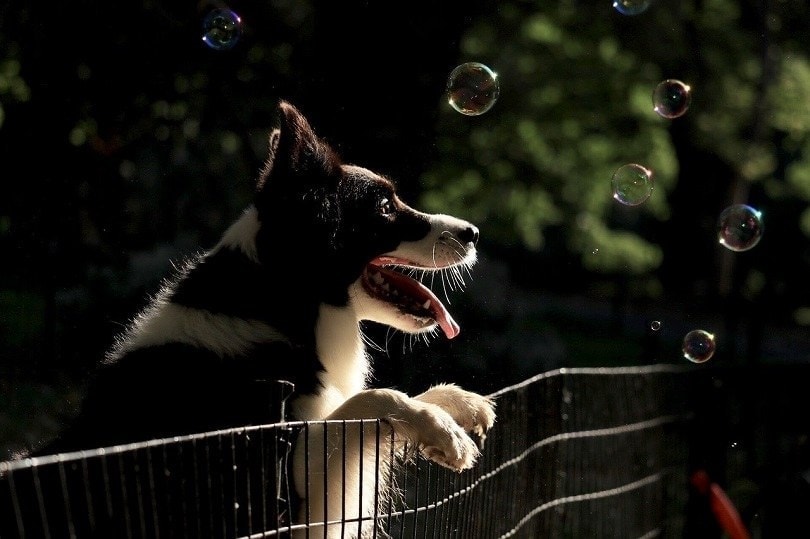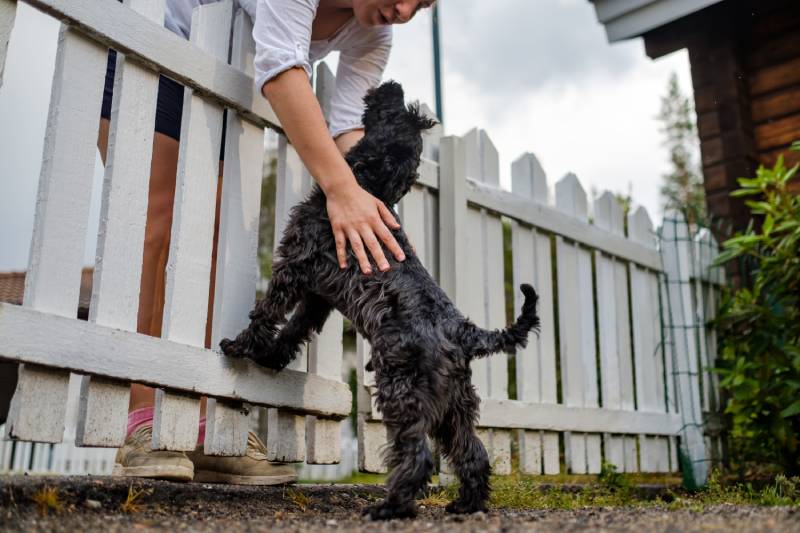How to Keep Your Dog from Jumping the Fence: 10 Simple Ways
By Grant Piper
Updated on

One of the scariest things to see is your dog taking off like a flash across the yard and then somehow using super doggy agility to jump up and over your fence. Having a dog escape the yard can be frustrating and dangerous for you and your pet. Some people feel helpless when they can’t prevent their dog from leaving the yard whenever they choose. But don’t worry. There are a number of practical solutions that you can try to help keep your dog safe and where they belong.
Here are 10 solutions and tips to help keep your dog from jumping the fence that you can try today.
The 10 Simple Ways to Keep Your Dog from Jumping the Fence
1. Identify What Causes Your Dog to Jump the Fence
The first thing you should do is watch your dog and try to identify what is causing them to jump over the fence. Each dog will jump the fence for a different reason. Some dogs see animals like squirrels which causes them to go into chase mode. Some dogs smell something in the wind that they want to investigate. Some dogs are simply bored and want to get out and try to have some fun.
Identifying the primary reason why your dog is jumping the fence and trying to escape can help you decide on the best method to prevent your dog from jumping. Every one of these solutions is different, and they all won’t work for your particular dog. Finding out what is driving your dog’s behavior will help you pick a solution that has the highest chance of working.

2. Give Your Dog Plenty to Do Inside the Yard
The first thing you can try is offering your dog plenty of things to do inside the yard. This can include toys, bones, a hose, or even a kiddie pool. Figure out what your dog likes to do outside and try to enhance their experience. Giving your dog a reason to stay in the yard will help prevent them from trying to leave the yard by leaping over your fence. This also has the benefit of not having to do anything to the fence.
3. Make Sure Your Dog Is Getting Enough Exercise
Pent-up energy can be a factor that drives your dog to jump the fence. Making sure that your dog is getting plenty of energy can help them stay put. Take your dog on long walks at least twice per day. Play fetch or chase in the yard to burn off some additional energy. You can also take your dog to the dog park or to a doggy playdate to get them some extra socialization with other dogs. These activities can help wear your dog out and prevent them from sailing over your fence.
4. Consider Spaying or Neutering Your Dog
One thing that can cause your dog to act like a fool and try to desperately escape the yard is a sexual drive. Dogs will periodically go gaga for the opposite sex, and that can cause your dog to jump over the fence in excitement or desperation. Many animals, both wild and domesticated, will go roaming for mates and the desire to find a mate can be a powerful force. Getting your dog spayed or neutered will eliminate these urges and can prevent them from going over the fence in search of a mate.

5. Block the View to the Outside
Some dogs get triggered by seeing things through the fence that entice them. This can be anything from a bird or squirrel to a biker or stranger walking past the house. If you build a screen or replace your chain-link fence with a wooden board fence, you can prevent your dog from seeing something that will cause them to want to go up and over the fence. By removing visual cues, you can remove many potential triggers that cause fence-jumping behavior. Think about it as a blinder for your dog that helps keep them from getting distracted or excited by things outside of the yard.
6. Add Angled Fence Extenders
Many people suggest putting fence extenders on top of the fence. Fence extenders use poles to raise the fence to a greater height. Fence extenders can be effective, but they are even more effective if you angle them. Angling the fence extenders inward at a 45-degree angle will prevent your dog from being able to reach the top of the fence. Some dogs have been known to jump through or destroy mesh fence extenders if they are simply vertical and not angled inward.
7. Plant or Add Obstacles Along the Fence Line
Another way to prevent your dog from jumping over the fence is to install some barriers around the fence that will prevent your dog from getting close enough to jump. Practical barriers include shrubs, small trees, and bushes. These types of barrier plants will prevent your dog from getting a full running start at the fence. If a dog sees a line of bushes or trees in front of the fence, they are more likely to think twice before gunning it. Barrier plants can also help obstruct the view through the fence as well.

8. Add Coyote Rollers to Your Fence
Coyote rollers are round poles that spin that you attach to the top of your fence. These poles prevent your dog from getting a good purchase on the fence and will spit them back into the yard if they try to jump. They are named coyote rollers because they were invented to keep coyotes from jumping into your yard. You can buy coyote roller sets, or you can build your own using a simple PVC pipe that you can buy at your local hardware store.
9. Supervise Your Dog’s Outdoor Time
Additional supervision can also help break your dog of bad habits. Some dogs won’t try to escape the yard if you are there watching them. You can also use supervision to try and distract your dog from the fence or by giving them commands to stop them from leaping in the first place. Supervision is not practical for all people, but if you can bring a book and a glass of lemonade outside while your dog is in the yard, it could solve a lot of problems.
10. Remove Climbable Objects from the Fence Line
Some dogs use objects near the fence to help them jump over. Common culprits include lawn chairs, trash cans, and tree debris. Anything that is short enough for your dog to easily jump on and then jump to the fence can be a potential problem. Clearing the fence line of these objects and removing anything that your dog could use to help them clear the fence can make it harder for them to get over. For some dogs, this is enough to keep them inside the yard. If they don’t get a boost, they can’t make it over.

Make Sure Your Dog Can Be Identified If They Escape
If you are dealing with a bad fence jumping habit, make sure that your dog can be IDed if it gets out of the yard. Make sure your dog has a collar with an identification tag on it so that someone can call you if your dog runs off. You can also get your dog microchipped. Microchips can be scanned by most veterinarians and animal services and cannot come off the collar like a traditional tag. Some jurisdictions are even using facial recognition software for dogs that will scan your dog’s face and come back with a match if you have entered your dog into the database. Make sure your dog has some form of identification if they are escaping on a regular basis.
Conclusion
Fence hopping can be an extremely frustrating problem to deal with. Luckily, there are a number of potentially viable solutions that will help keep your dog in the yard where they belong. Some solutions are as easy as tiring your dog out more regularly, so they don’t have the energy to leave. Other solutions involve rebuilding or redesigning your fence to hamper escape artists. Choose a solution that you feel will fit your dog, your lifestyle, and your yard the best, and give it a try.
You Might Also Be Interested In:
Featured Image Credit: sergio souza, Pexels













